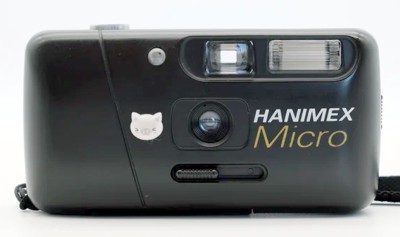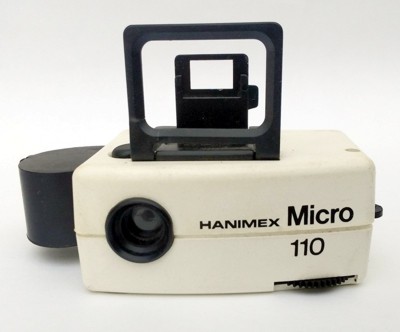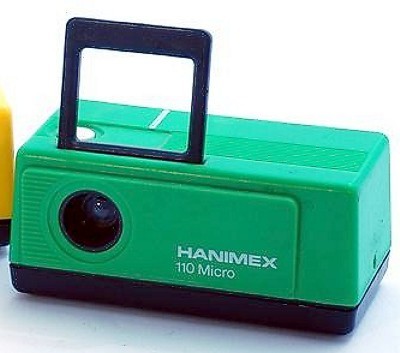
HANIMEX 110 CAMERAS

If you are able to provide more complete or accurate information than is listed here, please contact us.
F cameras -- Hanimex made lots of 110 cameras with an "F" in its name. These ranged from bare-bones models that could use a flash bulb to very sophisticated models with electronic flash units built in. Most of them are grouped together here to make some sense of all the countless models.
It has a flip-over cover that turns into a handle or "Auto-Grip". Other than that it appears pretty basic, but it has an interesting switch on the top that appears to select for 100 or 400 speed film, but it does more than that. While the camera has a fixed shutter speed, it has two aperture settings -- "open" and "stopped down". For 100 speed film, there is only one selection on the switch. That opens up the aperture for daylight, but you can add a Flip-flash for lower light situations. For 400 speed film, you can set the lever for sunlight (stopped down) or for cloudy/flash use (opened up). It was also sold as the Halina 110 Auto-Flip, the CTC 110 Pocket, and the Haking Grip-C.
It's a basic 110 with a built-in flash. Fixed-focus lens with fixed shutter speed. The only exposure control is to turn the flash ON or OFF. It has a small grip on one end.
Same as the CF, but has a switch on top to select normal or tele lenses. Same built-in flash.
Basically the same as the CF (above) but in a more stylish, silver body. The "hand grip" is gone.
Often referred to simply as the "Hanimex DTF" because those letters are capitalized, the 110DFTele is basically the same as the CF Tele (above) but in colors -- red, white, pink, yellow, etc., and black, too! 25mm and 43mm switchable lenses with a selection switch on top. Built-in electronic flash with an ON/OFF switch on top. Uses two AA batteries. Basically the same as the Tele 110 TF (below) but with the controls in different places on the top.
(1977) This camera should not to be confused with the Hanimex MINI 110 EF (below). The AUTO SIGNAL EF is actually much smaller than the MINI 110 EF, in part because it uses the body of the PF cameras (see below) with the cushioned grip. It's also smaller because it lacks the built-in flash of the MINI 110 EF. The AUTO SIGNAL EF is a rather basic 110 model, but it has an "auto signal" to indicate if a flash needs to be used for correct exposure. While it lacks the Flip-flash connection of the PF cameras, it has a special connection on the end for special electronic flash units. 27mm f8, (3/3) fixed-focus lens. Mechanical shutter with speed of 1/125. No exposure control. Uses four AAA batteries. Also sold as the Hanimex WS (below).
Not to be confused with the Hanimex MINI EF TELE (below) -- which is MUCH larger -- the EF TELE-HANOMATIC, uses a PF camera body, but lacks the signalling system of the AUTO SIGNAL EF (above). Instead, it has a normal and a tele lens that are chosen with a lever on the top. Dual lenses. 20.5mm f5.6 and 40mm f 5.6. Like the AUTO SIGNAL EF, it lacks a Flip-flash socket, but accepts special electronic flash units on the end. Mechanical shutter with speed of 1/200. Flash speed of 1/125. No exposure control. Often referred to as the IEF Tele-Hanomatic or the IEF Tele-Wide. Uses four AAA batteries.
It's your basic 110 camera with a built-in electronic flash. Available in silver or black. Uses two AA batteries.
(1977) 27mm (f8), (3/3) fixed-focus lens. Mechanical shutter with speed of 1/125. No exposure control. Built-in hot shoe, and optional electronic flash which uses two AA batteries -- and is almost as large as the camera! It was also sold under the Sedic label -- which made several Hanimex cameras -- as the Sedic 22 X.
It's 20.5mm f5.6 fixed-focus lens gives a 20% wider view. It has a PF-style body, and has a 1/200s shutter speed. It accepts accessory electronic flash units.
The "ES" probably stands for "Electronic Shutter", because that's what this model has. It sets the correect shutter speed from 10s to 1/300. It has a fast 27mm f5.6 (3/3) lens that has three focus settings that are set with a lever on the top. It has a PF-style body and uses one K-battery plus two AA batteries. Also sold as the Hanimex ES (below).
An updated version of the original IEF with a wider 22mm, and faster f5.6 lens. And now the flash is built in. The only exposure control in flash ON or OFF. Requires two AAA batteries.
It's your basic 110 camera with a built-in electronic flash. It has a 27mm f11, fixed-focus lens, and a shutter speed of 1/90 -- or 1/45 if the flash is used. It uses two AA batteries.
It's another basic 110 with a built-in flash -- but in a longer body. Hopefully this made the flash a little stronger. Fixed-focus lens with fixed shutter speed. The only exposure control is to turn the flash ON or OFF. It has a small grip on one end.
Same as the LF, but has a switch on top to select normal or tele lenses. Same built-in flash.
The "MT" stands for "MOTOR DRIVE" -- which someone thought would help 110 sales. It's big and heavy, despite being marked "MINI" on the body. It also has a built-in electronic flash and TWO lenses -- 22mm and 44mm, selected with a switch on the top. A sensor determines if the flash needs to fire. Uses two AA batteries.
25mm and 43mm switchable lenses with a selection switch on the top. Built-in electronic flash with an ON/OFF switch on top. Uses two AA batteries. Basically the same as the 110DFTele (above) but with the controls in different places on the top -- and not available in a rainbow of colors.
This model is similar to the MTF model (above), but only has a normal lens. Available in silver or black.
This model appears on some lists, but it does not exist. Probably a confusion with a different model -- see the V-models (below) which did have a zoom lens.
LOADMATIC -- Many of Hanimex cameras were labeled "LOADMATIC". These
ranged from movie cameras (and projectors) to 126 cassette cameras -- and a few were 110 cassette cameras.
It didn't make its appearance in the year 2000 -- that's for sure -- nor does it have a top speed of 1/2,000s. It's a very basic 110 camera with no exposure control -- but it does have a sliding lens cover, and it accepts Magicubes.
A step up from the 2000 Loadmatic, this model is still pretty basic, but it adds a CdS cell to indicate if a Magicube is needed for a better exposure.
(1973) A very early, top-of-the-line, 110 camera with a fast 26mm f2.7-16, (4/3) zone-focusing lens, controlled by a lever on the top plate. It has an electronic shutter with speeds from 6 seconds to 1/250. Magicube flash speed of 1/40. The CdS meter provides programmed exposure control of both the f-stop and shutter speed in combination, and uses a 544 battery. The camera itself is marked "Hanimex IC 110 Pocket Electronic Loadmatic". but sometimes called the "Hanimex S".
MINI / MICRO -- Several of Hanimex cameras were labeled "MINI" or "MICRO", but not all of them were 110 cameras. Here are the ones that were:
(1975) The original Hanimex 110 Mini, it has a 25mm f9, fixed-focus lens. Shutter speeds of 1/200 and 1/60 for flash. Film advance in the pull-push Minox style. Accepts Magicubes, and was sold with a cube extender to avoid "Red-Eye". There no control of the exposure, but if you want a tiny 110 camera, this is it.
(1977) I wouldn't call this camera "Mini", but Hanimex did because it "folds up" with its push-pull, Minox-type design. It has a fast f5.6 lens, and a built-in electronic flash that takes four AAA batteries -- that's what the "EF" means. When opened up, it's as big and heavy as any big 110 camera.
Similar to the Mini 110 EF, but even larger -- with two lenses -- 24mm and 43mm, controlled by a lever on the top. Two apertures -- f9.5 for daylight and f5.6 for flash use. Built-in electronic flash that uses four AAA batteries.
It's labelled "MINI", but it really isn't. See MTF (above)
Similar to the oriiginal Mini 110, it's a small, bare-bones 110 camera with film advance in the pull-push Minox style, and an f9.5 fixed-focus lens. No focusing or exposure control, but this updated model accepts a Flip-flash. Like the original, it has one shutter speed for daylight, and another for the Flip-flash.
Hanimex made a lot of 110 with similar, confusing names. This one, the MICRO, should not be confused with either of the two Hanimex MICRO 110 cameras below. This one is a completely different design -- looking like a small 35mm P&S camera. The only difference is that is uses 110 film and is much smaller and lighter. It has a sliding lens cover with a built-in flash.

Hanimex made two cameras with the "Micro 110" name. The more common is the larger version -- and is labelled "Micro 110". It's not as small as some other 110 cameras with the same name ("Micro"), but still, this is a bare-bones camera with one shutter speed and aperture setting. It was used by many companies for promotional purposes, such as the Kraft cameras.

The other Hanimex Micro 110 camera is smaller, more like the keychain cameras. This one is labelled "110 Micro", and is the same as the Mini 110 -- see 110 camera list.

PF -- Hanimex sold a line of three cameras that were labeled "PF". The only thing these three cameras have in common is a similar body style -- compact, all black with an unusual, cushioned "grip" on the right-hand end with the shutter release. All of them could accept a Flip-flash, but they could also use special electronic flash units, such as the Hanimex PFX33 or SFX40 flashes -- that plug into the Flip-flash socket!
This was the low-end PF model, but it was a step up from the real bare-bones models that Hanimex sold, such as the POCKET 100 that had a one-element f11 lens. The DF228 has a three-element, all-glass, f8 lens, and two shutter speeds -- one for daylight, and one for flash.
A step up from the PF228, the PF428 has a faster f6.3 lens, but more important, this model has an electronic shutter to control the exposure from 1/30 to 1/300.
While this model lacks the auto-exposure of the PF428, it has dual lenses. It has a 25mm normal lens and a 42mm tele lens that is changed with a lever on the top.
(1977) 27mm f5.6, (3/3) three-setting zone-focusing lens. Electronic shutter with speeds of 10 seconds - 1/300. Flash speed of 1/45. The CdS meter provides control of the shutter speed. Uses a K battery. Same as the IEF ES (above).
(1977) 27mm f8, (3/3) fixed-focus lens. Mechanical shutter with speed of 1/125. No exposure control. Same as the AUTO SIGNAL EF (above), with low-light warning in viewfinder. Uses a K battery.
This is the most basic Hanimex 110 camera. It has a one-element, 27mm f11, fixed-focus lens. The mechanical shutter has a speed of 1/90, but if a Magicube is attached, it switches to 1/45. No exposure control, other than that.
It's basically a Pocket 100 with the same lens, but flipped over, so the viewfinder is now on the opposite end, and the film advance is on the top with a "wheel" film advance..
An updated Hanimette. The main feature change is that this model uses Flip-Flash instead of Magicubes.
Same as the Hanimette 108, but in a slightly (?) more stylish body.
Very lightweight with an f9.5 lens and two shutter speeds. It accepts a Flip-flash, but an electronic flash can also be attached instead.
Same as the Pocket 100, but in a slightly (?) more stylish body..
Bare-bomes 110. Probably one-element f11 lens. Takes Magicubes.
It has a 20mm f4.0, fixed-focus lens with a single shutter speed of 1/125. Also a pretty essential -- under water, anyway -- built-in flash. It's waterproof to 45 meters down -- so it's no slouch. It has two over-sized control knobs in a bright yellow or pumpkin-orange body covering. It is shaped more like a pocket 35mm than the standard 110 bar camera, and uses two AA batteries -- just for the flash and motor drive. It will work with 16mm perforated film, with a minor modification to the operating procedure. The motor drive will advance the film about 15mm when the perforations are in the path of the perforation sensor arm. Thus it appears to skip one perforation in the advance cycle. Therefore, by 'shooting' a 'blank' frame (i.e., firing the shutter with the lens covered such as with your hand) and allowing the motor drive to advance the film again it accepts perforated film without any frame overlap. This should place the frame separation at about 30mm instead of the normal ~25mm – wasting a small amount of film.
This Hanimex camera -- without the "110 MF" -- LOOKS almost exactly like the Amphibian 110 MF, but it is a 35mm camera.
V-cameras -- Hanimex sold a line of 110 cameras that had a vertical body style, instead of the common, 110 horizontal shape. Their names all start with a "V", as a result. While the cameras were larger, with the different body shape, they were able to have some exceptional features for 110 cameras.
(1978) Shaped more like a 35mm rangefinder camera, it was pretty big for a 110 camera. Fixed-focus 26mm f9.5 lens. Shutter speed of 1/125. Built-in, pop-up flash and tripod socket. Used 100 and 400 speed film. Uses two AA batteries.
(1978) Deluxe version of the VIF 100 with wider & faster, fixed-focus, 20.5mm f4.0 lens. Sharp from 3 feet to infinity. Shutter speed of 1/200. Used 100 and 400 speed film. No flash shoe because it has a built-in pop-up flash. Uses two AA batteries.
(1977) Same f4.0 wide-angle lens as the VIF 110, but with three-position aperture settings, and a slide-in, close-up lens. Fixed-focus. Special clip-on Hanimex VEF flash unit that uses two AA batteries.
An updated VEF. No, it's not more compact, but now it's all black. So maybe it looks smaller. More importantly, the slide-in close-up lens in gone, and a hot shoe is added to the top -- so any flash can be used!.
(1975) Deluxe version of the VEF with 26-42mm f5.6 zoom lens. Two aperture settings: f11 for sun and f5.6 for indoors. Fixed 1/125 shutter speed. Focusing from infinity to 1.5 feet. Special clip-on Hanimex VEF II flash unit which needs two AA batteries.
(1979) Focusing four-element 25mm very fast f1.9 lens. Focusing to three feet. Shutter speed of 1/30 - 1/100 electronically controlled by CDS meter. Extra large viewfinder with LED's to indicate over and under-exposure. Hot shoe, tripod socket and cable release socket. Shaped more like a 35mm rangefinder camera, it was pretty big for a 110 camera. Used 100 and 400 speed film. Uses a K battery.
XP -- Hanimex sold at least TWO cameras labeled "XP". These were rebadged SEDIC cameras (which also sold XP-labeled 110 cameras -- see SEDIC 110 cameras).
(1976) Since this camera was made by Sedic, and since Sedic sold a 110 camera called the XP1, you might at first think that this is simply a rebadged Sedic XP1. That may be the case, but it also could be a re-badged Sedic SPORT which has the same features too. Like most 110 cameras, this camera was sold in a kit, which included an unusually large, clip-on accessory to accept Magicubes. The camera is pretty basic with a 26mm f9.5 (3/3), fixed-focus lens and a fixed shutter speed, but oddly enough, it has tripod and cable release sockets. Some of the Sedic 110 accessories -- there were many, such as a close-up lens, and wide-angle & telephoto converters, might work with this camera.
(1974) Since this camera was made by Sedic, and since Sedic sold a 110 called the XP2, you might at first think that this is simply a rebadged Sedic XP2. In fact, it's a re-badged Sedic 110 POCKET 504. It has a fast 26.5mm f5.6, (3/3) 3-zone-focusing lens. Electronic shutter with speeds of 10 seconds - 1/400. CDS meter provides semi-programmed exposure control. Tripod and cable release sockets. Many of the Sedic 110 accessories -- there were many, such as a close-up lens, and wide-angle & telephoto converters, will work with this camera.

To return to the main index for the Sub Club click here.
COPYRIGHT @ 1995-2025 by Joe McGloin. All Rights Reserved.